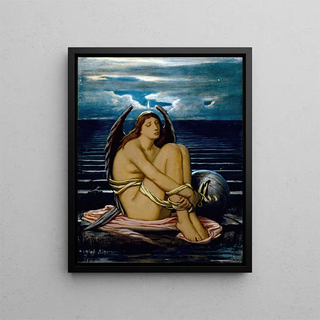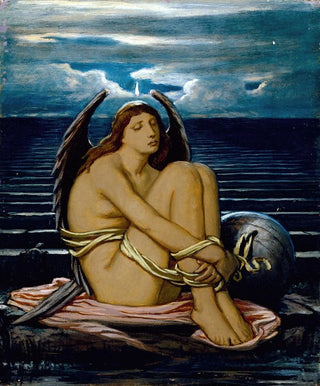Painting L'âme en esclavage - Elihu Vedder | Art print


View from behind

Frame (optional)
In the world of art, some works transcend the simple frame of the canvas to evoke deep emotions and reflections on the human condition. "L'âme en esclavage" by Elihu Vedder is one of these powerful creations. Through this piece, the artist invites us to contemplate internal struggles and the suffering that inhabit the human soul. The symbolic representation of slavery, both physical and spiritual, resonates with an intensity that endures through the centuries. Vedder, with his mastery of symbolism, manages to capture the very essence of pain and hope, offering a poignant reflection on freedom and redemption.
Style and uniqueness of the work
"L'âme en esclavage" stands out for its unique stylistic approach, blending elements of symbolism with refined pictorial execution. The dark colors and skillfully used shadows create an atmosphere of mystery and melancholy. Vedder, a virtuoso of light, plays with contrasts to highlight the central figures of his composition. The human figure, both vulnerable and resilient, is surrounded by an environment that seems both oppressive and protective. The meticulous details, such as drapery and facial expressions, demonstrate a deep understanding of anatomy and human emotions. This work, far from being a simple illustration, becomes a true exploration of the soul, inviting the viewer to introspection about their own invisible chains.
The artist and his influence
Elihu Vedder, born in 1836, is a significant figure in the American symbolist movement. Influenced by European artistic currents while remaining rooted in his American identity, Vedder developed a style that is uniquely his own. His fascination with spiritual and mythological themes is reflected in his works, where he seeks to express complex ideas through symbols. "L'âme en esclavage" fits into this quest for inner truth and the representation of the invisible. The artist was also a pioneer in using literature and poetry to enrich his pictorial approach. His influence continues

Matte finish

View from behind

Frame (optional)
In the world of art, some works transcend the simple frame of the canvas to evoke deep emotions and reflections on the human condition. "L'âme en esclavage" by Elihu Vedder is one of these powerful creations. Through this piece, the artist invites us to contemplate internal struggles and the suffering that inhabit the human soul. The symbolic representation of slavery, both physical and spiritual, resonates with an intensity that endures through the centuries. Vedder, with his mastery of symbolism, manages to capture the very essence of pain and hope, offering a poignant reflection on freedom and redemption.
Style and uniqueness of the work
"L'âme en esclavage" stands out for its unique stylistic approach, blending elements of symbolism with refined pictorial execution. The dark colors and skillfully used shadows create an atmosphere of mystery and melancholy. Vedder, a virtuoso of light, plays with contrasts to highlight the central figures of his composition. The human figure, both vulnerable and resilient, is surrounded by an environment that seems both oppressive and protective. The meticulous details, such as drapery and facial expressions, demonstrate a deep understanding of anatomy and human emotions. This work, far from being a simple illustration, becomes a true exploration of the soul, inviting the viewer to introspection about their own invisible chains.
The artist and his influence
Elihu Vedder, born in 1836, is a significant figure in the American symbolist movement. Influenced by European artistic currents while remaining rooted in his American identity, Vedder developed a style that is uniquely his own. His fascination with spiritual and mythological themes is reflected in his works, where he seeks to express complex ideas through symbols. "L'âme en esclavage" fits into this quest for inner truth and the representation of the invisible. The artist was also a pioneer in using literature and poetry to enrich his pictorial approach. His influence continues
12,34 €






